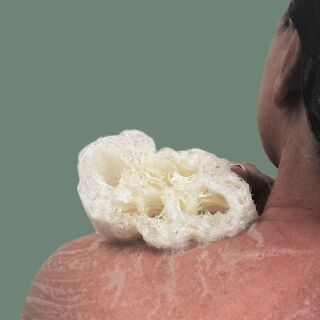A Quick Guide To Exfoliation
Dermatologists note that cell turnover slows as we age, but even in younger skin, factors like pollution, sun exposure, and lifestyle can cause buildup and dullness.
There are different types of exfoliators:
- Mechanical - such as a loofah, sugar scrub or a brush.
- Chemical exfoliators - such as acids and enzyme treatments.
- Professional treatments - such as microdermabrasion.
In this article we're focusing on the mechanical, natural exfoliators that you can use at home and do yourself to brighten and freshen up your skin.
Reasons to exfoliate:
- Smooths and Brightens Skin: Cleanses away dead skin cells and dirt and grime buildup.
- Encourage new skin cell growth and stimulate circulation.
- To remove old tanning product.
- Clean and polish up skin before tanning.
- Evens skin texture: Helps to smooth out the skin before shaving.
- Enhances hydration and absorption as clearing away buildup on the skin can also help the skin absorb topical products such as skin creams and balms allowing them to be more effective.
How Often Do I Exfoliate?
When it comes to how often to exfoliate, there’s no one-size-fits-all rule. It depends on your skin type, the exfoliation method you use, and your environment.
General Guidelines
Follow labelling instructions on products or specific dermatologist advice if given.
- For most people using a gentle exfoliation such as a soft loofah or an exfoliating soap: Every 2-3 days may be suitable, allowing the skin to repair in between uses.
- For a more aggressive exfoliation: 1-2 times a week
- Dry or sensitive skin: Once weekly with gentle methods.
- Oily or thicker skin: May tolerate up to 3 times weekly, but still avoid over-scrubbing.
- Chemical exfoliants (like acids and fruit enzymes): Best kept to 1–2 times per week unless advised by a dermatologist.

Signs You’re Over‑Exfoliating
If you notice redness, stinging, peeling, or dryness, scale back your routine. Over-exfoliation can damage your skin barrier and make you more sensitive to the sun.
The skin is the largest organ of the body and is exposed to the elements so it's important to find an exfoliating product that is strong enough to cleanse the top layer of the skin but gentle enough so as not to cause any abrasions or damage to the skin.
If you're unsure, it's recommended to exfoliate every three days, this gives the skin cells a chance to repair and regenerate.
There are a range of natural exfoliating products:
- A loofah: Can be used dry (dry brushing) or wet with different consistencies for different parts of the body
- Exfoliating soap: Usually with poppy seed, walnut, pumice, apricot kernel or shredded loofah or loofah slices. As there is such a variety of scrubiness in soaps, we recommend doing a test patch first as some materials can be too scratchy for the skin.
- An exfoliating body wash: In liquid form that has an exfoliant added
- A body scrub: Usually made from sugar or coffee. Tip: mix with a mild oil like jojoba or olive to hydrate as you exfoliate.
- A body brush: Can be used dry or wet
- An exfoliating glove: Can be used dry or wet
- A pumice stone: Usually used on the soles of the feet
How to exfoliate with a loofah
- Soak/wet loofah in warm water to soften - if you want to make a loofah really soft quickly, dunk it in hot water.
- You can add soap directly to the loofah or lather up on body then begin exfoliating.
- Starting at the top of the body (the back of the neck) moving in large circular motions and moving down the body. Applying only gentle pressure to sensitive areas like under the arms. Paying special attention to areas like the elbows, knees and ankles.
- Rinse soap off body with warm water
- Rinse loofah and hang to dry.
- Pat body dry and moisturize if needed.
Tips for Safe Exfoliation
- Test new scrubs or tools on a small patch first.
- Use gentle, circular motions for no more than 30 seconds.
- Avoid exfoliating over cuts, sunburn, or irritated skin.
- Always moisturize after exfoliating to keep skin soft and hydrated.
- Apply SPF if skin will be exposed to the sun after exfoliation.
Whether you choose a loofah, body brush, sugar scrub, or gentle exfoliating soap, the key is to exfoliate regularly but gently. Listen to your skin, moisturize well, and enjoy the smoother results.
Facial Exfoliation – A Quick Note
Facial skin is more delicate than the body, so it’s important to choose gentler exfoliation methods. There's a completely different range of specific face exfoliation products and some of the products mentioned above are not suitable for the face, for example we don't recommend using our body loofahs on the face but instead sell a baby loofah with more delicate and softer fibres specifically for this purpose.
Posted: Thursday 7 August 2025


